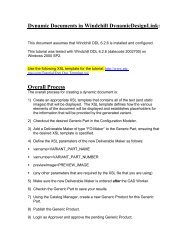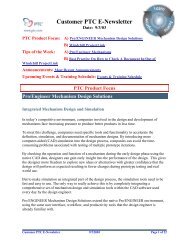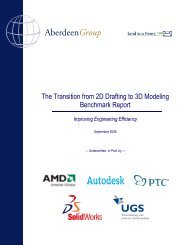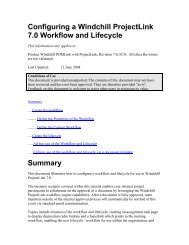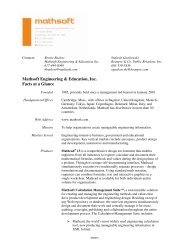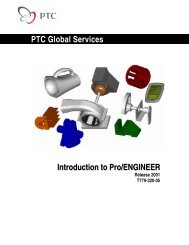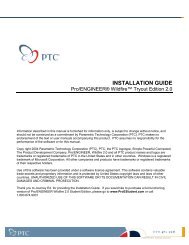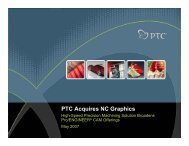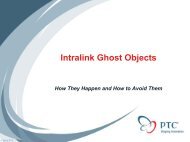Mitsubishi Heavy Industries standardizes on Product ... - PTC.com
Mitsubishi Heavy Industries standardizes on Product ... - PTC.com
Mitsubishi Heavy Industries standardizes on Product ... - PTC.com
You also want an ePaper? Increase the reach of your titles
YUMPU automatically turns print PDFs into web optimized ePapers that Google loves.
Case Study<br />
MHI’s Nagasaki Shipyard uses <strong>PTC</strong><br />
Windchill ®<br />
to Standardize Processes<br />
and Manage All Development Data<br />
Maker of turbochargers for ship diesel engines installs <strong>PTC</strong>’s <strong>Product</strong><br />
Lifecycle Management (PLM) soluti<strong>on</strong> for business-process standardizati<strong>on</strong><br />
and BOM-centric PLM<br />
<str<strong>on</strong>g>Mitsubishi</str<strong>on</strong>g> <str<strong>on</strong>g>Heavy</str<strong>on</strong>g> <str<strong>on</strong>g>Industries</str<strong>on</strong>g>, Nagasaki Shipyard & Machinery Works,<br />
Tokyo, Japan<br />
<str<strong>on</strong>g>Mitsubishi</str<strong>on</strong>g> <str<strong>on</strong>g>Heavy</str<strong>on</strong>g> <str<strong>on</strong>g>Industries</str<strong>on</strong>g>, Ltd. (MHI), founded in 1884, has the world’s sec<strong>on</strong>dlargest<br />
market share for turbochargers for vessel-propulsi<strong>on</strong> diesel engines. The<br />
<strong>com</strong>pany’s Nagasaki Shipyard and Machinery Works was established to produce turbochargers<br />
for MHI’s <str<strong>on</strong>g>Mitsubishi</str<strong>on</strong>g> UE diesel engines. Without turbochargers, marine<br />
engines could generate <strong>on</strong>ly 20–30% of the power necessary to propel a vessel at the<br />
desired speed. The MHI Nagasaki Shipyard’s turbochargers are respected worldwide<br />
for their high quality, excepti<strong>on</strong>al reliability, and ease-of-use.<br />
MHI turbochargers help optimize the speed performance<br />
of vessel diesel engines.<br />
The Challenge: Establish a Standardized Process for Building<br />
New Turbochargers<br />
• Manage all CAD and product development data created across<br />
the enterprise<br />
• Establish a BOM-centric approach to product development<br />
• Find product c<strong>on</strong>figurati<strong>on</strong>s and change informati<strong>on</strong> faster and easier<br />
• Quickly identify and deliver appropriate parts for faster service and support<br />
Page 1 of 4 | <str<strong>on</strong>g>Mitsubishi</str<strong>on</strong>g> <str<strong>on</strong>g>Heavy</str<strong>on</strong>g> Industry<br />
<strong>PTC</strong>.<strong>com</strong>
Case Study<br />
• Centrally manage and access all product data and after-market<br />
support informati<strong>on</strong><br />
The Soluti<strong>on</strong>: <strong>PTC</strong> Windchill<br />
• A powerful, <strong>com</strong>prehensive <strong>Product</strong> Lifecycle Management (PLM) soluti<strong>on</strong><br />
• Provides easy access to product informati<strong>on</strong> from a Web browser<br />
• Includes data management, as well as change and c<strong>on</strong>figurati<strong>on</strong> management<br />
• Creates a single source of product data–centrally located for easy access<br />
• Ensures that product development stakeholders are using the latest versi<strong>on</strong><br />
of data<br />
The Results: Reduced Time-to-Design New <strong>Product</strong>s by 87%<br />
• Also reduced the time-to-design variants when reusing existing data by 55%<br />
• Improved product development productivity, collaborati<strong>on</strong> and efficiency<br />
• Enabled users to better manage and understand all changes to<br />
product c<strong>on</strong>figurati<strong>on</strong>s<br />
• Improved management of project status informati<strong>on</strong>, workflows, 3D models and<br />
2D drawings<br />
10,000+ Units Shipped<br />
MHI’s turbocharger products, which support a wide range of diesel engines with<br />
between 500kw and 28,000kw outputs, are delivered from its Tokyo headquarters<br />
to shipbuilders and engine manufacturers around the world. The <strong>com</strong>pany has the<br />
world’s sec<strong>on</strong>d largest share of this market, having shipped more than 10,000 units<br />
to date.<br />
With l<strong>on</strong>g lifecycles for vessels, fast and reliable access to data is<br />
critical to efficient service and maintenance.<br />
Page 2 of 4 | <str<strong>on</strong>g>Mitsubishi</str<strong>on</strong>g> <str<strong>on</strong>g>Heavy</str<strong>on</strong>g> Industry<br />
<strong>PTC</strong>.<strong>com</strong>
Case Study<br />
Engineering Challenges and Aftermarket Support<br />
Once Nagasaki Shipyard and Machinery Works’ producti<strong>on</strong> reached 1,000 units per<br />
year, the Turbocharger Designing Secti<strong>on</strong> faced two critical challenges:<br />
1.) how to standardize <strong>on</strong> engineering processes, so as to stabilize product quality<br />
and increase cost-<strong>com</strong>petitiveness; and<br />
2.) how to maintain the quality of aftermarket support–which uses a limited number<br />
of resources–as the volume of producti<strong>on</strong> grew.<br />
Yasuhiro Wada, Group Leader of the Turbocharger Designing Secti<strong>on</strong>, proposed a<br />
system that would enable BOM-centric product data management. They selected<br />
<strong>PTC</strong>’s Windchill, a family of web-based <strong>Product</strong> Lifecycle Management (PLM) soluti<strong>on</strong>s<br />
that enable <strong>com</strong>panies to improve their product development processes by<br />
optimizing their data management, enterprise-wide project management, visualizati<strong>on</strong>,<br />
process management, and other areas<br />
of development.<br />
Benefits of Managing Structured BOMs<br />
When the Turbocharger Designing Team implemented <strong>PTC</strong> Windchill, they modified<br />
their bill-of-material (BOM) structure so it was better aligned to the product’s<br />
functi<strong>on</strong>al units and manufacturing processes. Their previous BOMs were very “flat”,<br />
without a deep hierarchical structure, a short<strong>com</strong>ing that limited development efficiency<br />
as many of MHI’s turbochargers are variants of existing designs. When working<br />
with flat BOMs, the work of selecting what <strong>com</strong>p<strong>on</strong>ents should be reused versus<br />
what would be developed, and then defining the specificati<strong>on</strong>s, was dependent<br />
mostly <strong>on</strong> individual engineers’ knowledge and skill sets.<br />
“The work–which required our engineers to find appropriate drawings, find the right<br />
part numbers, and look for the drawings for those particular parts–was a very timec<strong>on</strong>suming<br />
and cumbersome process,” explains Yasuhiro Wada.<br />
The MHI team, with the help of <strong>PTC</strong> Global Services, utilized the c<strong>on</strong>figurati<strong>on</strong> capabilities<br />
in <strong>PTC</strong> Windchill, so the soluti<strong>on</strong> enables MHI users to select opti<strong>on</strong>s and<br />
define product specificati<strong>on</strong>s for each order, based <strong>on</strong> a predefined master BOM.<br />
The benefits of implementing the soluti<strong>on</strong> were clearly identified in a pilot project:<br />
variant design reusing existing data to create a design, which previously required<br />
four hours of work, was cut by 55%. New product design, which previously required<br />
14 hours of work, has been reduced by 87%. “We were able to reduce design time<br />
while improving our product management practice,” says Wada.<br />
Page 3 of 4 | <str<strong>on</strong>g>Mitsubishi</str<strong>on</strong>g> <str<strong>on</strong>g>Heavy</str<strong>on</strong>g> Industry<br />
<strong>PTC</strong>.<strong>com</strong>
Case Study<br />
The soluti<strong>on</strong> has also had a major impact <strong>on</strong> the <strong>com</strong>pany’s after-market support<br />
process. Vessels have a l<strong>on</strong>g lifecycle of 40 years, requiring frequent servicing and<br />
maintenance of turbochargers. As MHI’s volume of product shipment increases, so<br />
does the number of units requiring service. Also, <strong>com</strong>p<strong>on</strong>ents are c<strong>on</strong>tinually being<br />
modified and improved to address market needs and to improve reliability.<br />
In the past, appropriate replacement parts were identified and delivered based <strong>on</strong><br />
the service history record, which c<strong>on</strong>tains the “as-shipped” BOM informati<strong>on</strong> and<br />
service history, al<strong>on</strong>g with informati<strong>on</strong> about the interchangeability of the parts.<br />
This process required advanced knowledge and experience, as well as many hours<br />
of manual work. Today, <strong>PTC</strong> Windchill centrally manages all change informati<strong>on</strong>,<br />
enabling users to easily find product c<strong>on</strong>figurati<strong>on</strong>s and change informati<strong>on</strong>, and<br />
quickly identify and deliver appropriate parts.<br />
Moving to PLM<br />
Based <strong>on</strong> its initial success with <strong>PTC</strong> Windchill, the MHI team expanded the system<br />
to support additi<strong>on</strong>al users, and began a next phase of the implementati<strong>on</strong> project,<br />
taking the soluti<strong>on</strong> from PDM to the world of PLM.<br />
“If we are afraid of making changes,” explains Wada, “we will risk being left behind.<br />
It was important for us to start centrally managing engineering changes, in additi<strong>on</strong><br />
to product informati<strong>on</strong>, in order to enable our team to c<strong>on</strong>tinue addressing market<br />
needs and requirements. A product informati<strong>on</strong> management soluti<strong>on</strong>, such as <strong>PTC</strong><br />
Windchill, enables us to manage and understand all the changes we make to product<br />
c<strong>on</strong>figurati<strong>on</strong>s. This way, we’re not afraid of making changes,” he says.<br />
<strong>PTC</strong> Windchill today is used to manage project status informati<strong>on</strong>, workflows, 3D<br />
models and 2D drawings. The MHI team has started a pilot project to manage product<br />
c<strong>on</strong>figurati<strong>on</strong>s, order files, and other types of informati<strong>on</strong>, and plans to manage<br />
projects and manufacturing processes. The <strong>com</strong>pany is also c<strong>on</strong>sidering using the<br />
<strong>PTC</strong> <strong>Product</strong> Lifecycle Management soluti<strong>on</strong>s in its sales and procurement groups.<br />
Going forward, Masataka Kimura, Secti<strong>on</strong> Manager, feels the team will be able to<br />
expand <strong>PTC</strong> Windchill system to the areas of envir<strong>on</strong>mental regulatory <strong>com</strong>pliance<br />
and supply chain management.<br />
© 2013, <strong>PTC</strong>. All rights reserved. Informati<strong>on</strong> described herein is furnished for informati<strong>on</strong>al use <strong>on</strong>ly, is subject to change<br />
without notice, and should not be c<strong>on</strong>strued as a guarantee, <strong>com</strong>mitment, c<strong>on</strong>diti<strong>on</strong> or offer by <strong>PTC</strong>. <strong>PTC</strong>, the <strong>PTC</strong> Logo, <strong>PTC</strong><br />
Creo ® , <strong>PTC</strong> Elements/Pro ® , <strong>PTC</strong> Mathcad ® , <strong>PTC</strong> Windchill, <strong>PTC</strong> Windchill PDMLink ® , Pro/ENGINEER ® , and all <strong>PTC</strong> product<br />
names and logos are trademarks or registered trademarks of <strong>PTC</strong> and/or its subsidiaries in the United States and in other<br />
countries. All other product or <strong>com</strong>pany names are property of their respective owners. The timing of any product release,<br />
including any features or functi<strong>on</strong>ality, is subject to change at <strong>PTC</strong>’s discreti<strong>on</strong>.<br />
J1364–MHI–CS–EN–0113<br />
Page 4 of 4 | <str<strong>on</strong>g>Mitsubishi</str<strong>on</strong>g> <str<strong>on</strong>g>Heavy</str<strong>on</strong>g> Industry<br />
<strong>PTC</strong>.<strong>com</strong>




